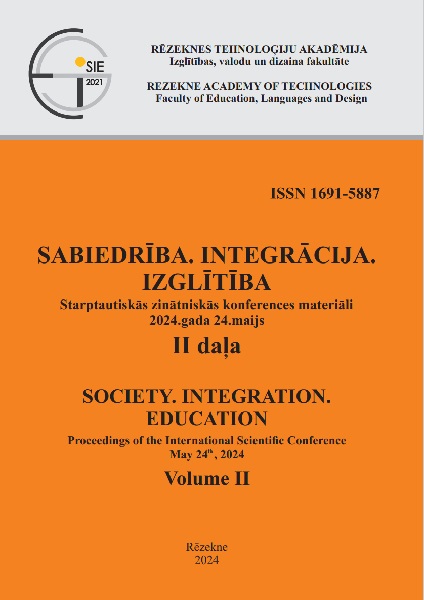THE NEW URBAN CONCEPT OF HANSEATIC CITIES OF THE RIGA ARCHBISHOPRIC IN THE 13TH–14TH CENTURIES
DOI:
https://doi.org/10.17770/sie2024vol2.7893Keywords:
architectural highlights, cathedral, church for the citizenship Catholic Parish, Hanseatic League, identity, medieval town planning, urban environmentAbstract
Bishop of Riga Albert established bishoprics and centers of spiritual life on the Southern Baltic Sea coast to subjugate the local population. Sacred buildings were the main architectural highlights of the urban environment. Later, Riga became the main military base for expansion in the Baltics, the economic base of the Teutonic Order, and the administrative center of the Archbishopric of Riga (1255–1562). On the Baltic Sea coast, new bishoprics began to be established in the lands of the subject Prussians. Important cities were involved in the Hanseatic League. Consequently, the concept of urban planning and construction changed in the 13th– 14th centuries. Research object: urban space of the Hanseatic League cities on the Prussian lands in the 13th–14th centuries. Research problem: sacral buildings changed urban aesthetics and the urban space of the Hanseatic cities, which has not been studied enough to preserve their identity. Research goal: analysis of the impact of churches for the citizenship parishes on the planning, visual image, and architectural-spatial development of the Hanseatic League cities in the lands of the subject Prussians. Novelty: analysis of common and local features of the structural evolution of the Hanseatic cities under the authority of the Archbishopric of Riga during the 13th and 14th centuries. Research methods: analysis of archive documents, projects, cartographic materials, and studies of published literature.
References
Caune, A. (1999). Bīskapa sētas Rīgā 13. gadsimtā. Latvijas viduslaiku pilis, I. Pētījumi par Rīgas arhibīskapijas pilīm. Rīga: Latvijas Vēstures institūta apgāds, 216-240.
Heise J. (1898). Die Bau- und Kunstdenkmäler des Kreises Marienwerder Östlich der Weichsel. Danzig: Commission-Verlag von Th. Bertling.
Jasiński, T. (1993). Die Rolle des Deutschen Ordens bei der Städtegründung in Preußen im 13. Jahrhundert. Quellen und studien zur Geschichte des Deutschen Ordens. Band 44. Internationalen Historishen Kommission zur Erforschung des Deutschen Ordens. Marburg: N. G. Elwert Verlag, 94-111.
Kranz-Domasłowska, L. (2013). Double cities in the Teutonic State on the example of Toruń. RIHA Journal, Article 0068.
Milicers, K. (2009). Vācu ordeņa vēsture. Rīga: Zvaigzne ABC.
Ozola, S. (2019). The Development of the Catholic Cathedral Building-type at Bishoprics’ Towns on the Baltic Sea Southern Coast during the 13th–14th Centuries. Landscape Architecture and Art, Vol. 14, No. 14, 23-43. DOI:10.22616/j.landarchart.2019.14.03
Ozola, S. (2023a). Spatial and Artistic Development of the Hanseatic Cities on the Baltic Seacoast in the 13th and 14th Centuries. Proceedings of 10th SWS International Scientific Conference on Arts And Humanities – ISCAH 2023. Vol. 10, Issue 1. 30 May–1 June, Florence, Italy. SGEM WORLD SCIENCE (SWS) Scholarly Society. 2023DOI:10.35603/sws.iscah.2023/fs09.14
Ozola, S. (2023b). The Influence of Churches of the Citizenship Catholic Parishes on the Layout and Urban Space of Medieval Towns in the 13th and 14th Centuries. Society. Integration. Education. Proceedings of the International Scientific Conference. Volume II, 26 May 2023. Rezekne: Rezekne Academy of Technologies Faculty of Education, Language and Design, 338-365. DOI: 10.17770/sie2023vol2.7119
Ozola, S. (2023c). The Influence of Churches for Citizenship Catholic Parishes on Urban Space and the Layout of Hanseatic Cities of the Archbishopric of Riga in the 13th and 14th Centuries. Proceedings of the 65th International Scientific Conference of Daugavpils University. Part C Humanities. Daugavpils: Daugavpils University.
Spruner, K., Perthes, J. G. (1854). Polen und Litthauen unter den Jagjellonen 1386–1572. Spruner K. 1854. Historich-Geographischer Hand Atlas zu Geschichte der Staaten Europa’s vom Anfarn des Mittelalters bis auf die Neueste Zeit. Drei und Seibzig colorirte Karten nebst erlauternden Vorbemerkungen. Zweite Auflage. Gotha: Justus Perthes.
Šīrants, R. (1978). Pilsētas apbūve 13. gadsimtā. Feodālā Rīga. Rīga: Zinātne, 420-425.
Šterns, I. (2002). Latvijas vēsture. 1180–1290: Krustakari. Rīga: Latvijas vēstures institūts.
Kajzer, L., Kołodziejski, S., Salm, J. (2002). Leksykon zamków w Polsce. Warsaw: Arkady.






